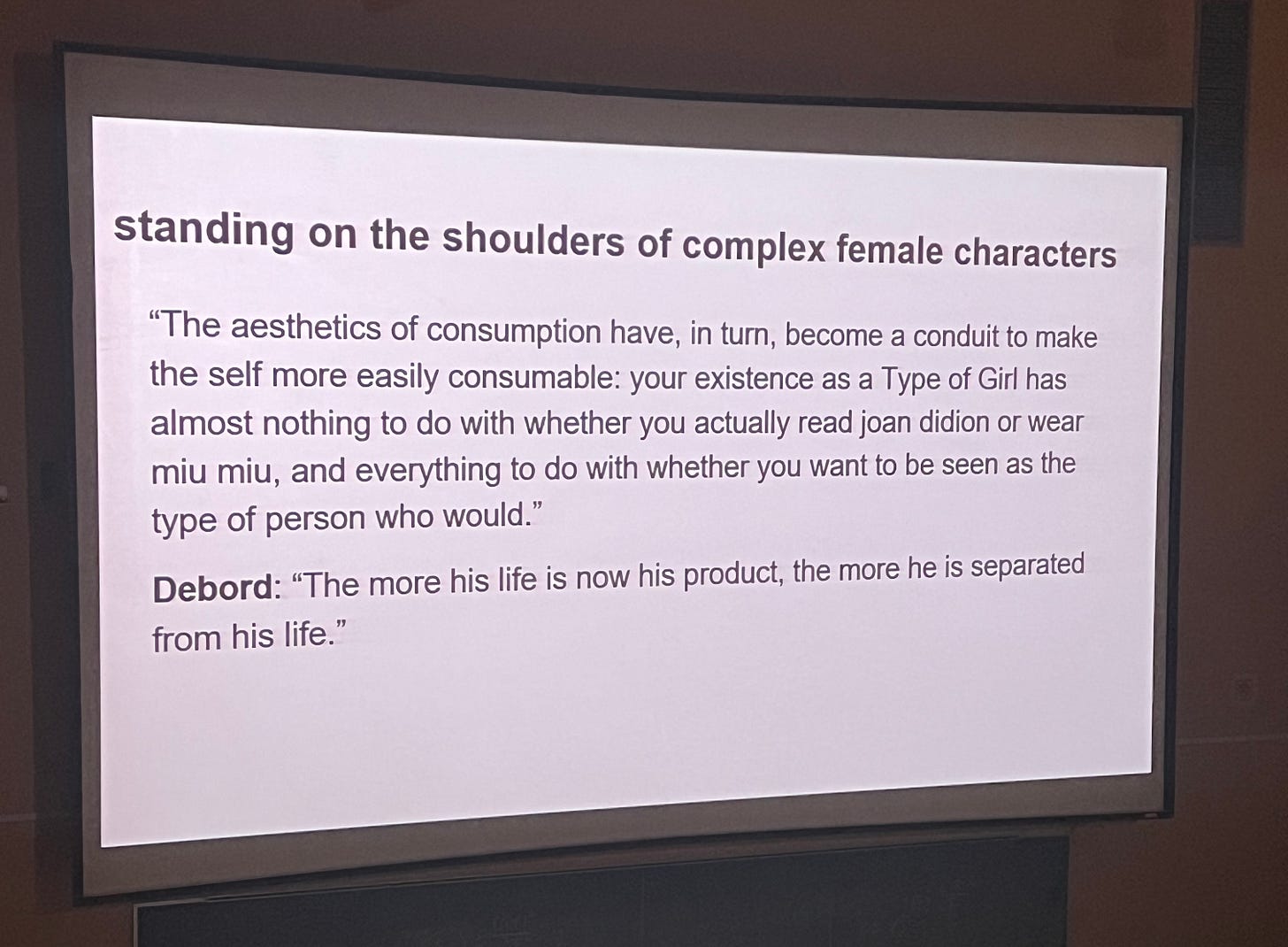the cruel optimism of the internet
commodification, identity, and the reflection of our lives in media
I recently saw an extremely cool talk by Rayne Fisher-Quann at McGill. She is insanely smart and also my Personal Hero, so naturally, I have lots to say.
Her talk, “girl online,” discussed the experience of women on the internet. Specifically, she mentions how female identities are often defined by consumption: women are made through the objects they purchase, photograph, and wear. Invoking Debord, she explains that content has reached a new level of performativity, in which items are used not for their practical purpose, but to curate identities. She mentions personas like the “English country grandmother” and the big city “it girl,” listing various items such girls might own.
However, RFQ also considers the paradox of attempting to achieve these identities: the first step to becoming an “it girl” is not caring too much about how others perceive you. So, if you consciously manage your image, you cannot be an “it girl.”
This sentiment made me think of the first chapter of “Cruel Optimism” by Lauren Berlant. Berlant practices affect theory, which is the critical study of feelings. The chapter discusses a method of understanding modern life by focusing on the implications of affective experience, affect being the nonlinguistic experience that precedes our emotions. Principally, Berlant explains the affective concept of “cruel optimism,” a relationship which exists when something you desire is actually an obstacle to your flourishing. They give the example of desperately wanting a relationship, which, when achieved, harms your well-being. To me, the concept of cruel optimism perfectly illustrates RFQ’s point about the paradoxical cycle of aesthetic achievement, where attempting to posture yourself as a particular kind of person becomes a fundamental roadblock to assuming that identity.
RFQ identified the economic implications of this experience, specifically its maintenance of the consumption cycle. She calls it the influencer “donkey and carrot,” where influencers dangle the tantalizing carrot of fulfillment just out of reach, keeping the donkeyed consumer in pursuit of an unobtainable goal. Berlant would call it cruel optimism. Optimism motivates consumer desire for the accoutrements of a certain “kind of girl” and thus influences purchasing behaviours. Cruelty keeps this consumption from resulting in a legitimate, lasting achievement of identity.
Additionally, Berlant’s chapter builds on RFQ’s sentiment by discussing the implications of cruel optimism for the affective experience of our generation. Berlant describes how cruel optimism often arises from the dissonance between traditional notions of work ethic, the “good life,” and bleak dissatisfaction with current working conditions. They point to the fantasy of customary steady wage labour, compared with the impermanence and instability of current careers. While we deeply desire a positive work life, contemporary capitalist work harms our well-being. I think that RFQ’s talk extends this phenomenon to social media, capturing the dissatisfying cycle of our fantasized result of consumption and its actually empty, identityless outcome.
Beyond RFQ’s identification of the economic implications of this cycle, Berlant suggests that cruel optimism contextualizes specific trends in modern media. Berlant explains how affective experience influences media forms by promoting depictions of human life with which we identify. Berlant points to soap operas, which have recently fallen in popularity because they no longer represent our lives. Inversely, there has been a rise in media depicting stories without distinct happy or sad endings, which instead reckon with instability and the experience of “muddling through” the confusing present. Examples like “I’m Thinking of Ending Things” come to mind, where narrative instability mirrors modern feelings of uncertainty. Essentially, Berlant claims that media forms succeed because they reflect our lives in a realistic and inherently sensical way.
Based on Berlant’s claim, I would argue that another media form resulting from modern affective experience is the highly stylized, commercialized content we see from influencers online. As RFQ explains, we are increasingly commodified both on and offline. Our attention, information, and identities are now the subjects of surveillance and commercialization; this process influences our affective experience, which manifests in various cultural capacities. For example, lifestyle content is one of the foremost genres on social media. However, as RFQ points out, this content rarely represents anyone’s lifestyle. Instead, this media often involves a highly aestheticized display of objects, each corresponding to the “lifestyle” associated with an aspirational identity. Since modern life entails so much commodification of ourselves and others online, this kind of digital media (which is actually thinly veiled advertising) not only encourages our overconsumption; it also makes inherent sense to us as a media experience, because it reflects our current reality. Watching a clip of “real life” on Tiktok, which is really a display of various objects, makes sense to a viewer living a life defined by things.
RFQ’s insights on the influencer “donkey and carrot” allow us to identify sources of modern capitalist overconsumption and understand some bizarre online identity trends. She explains that capitalism is why personalities are now linked to Amazon storefronts. However, I think there is more to that answer. As media is a manifestation of our experience, online content prevails because it reflects contemporary life. We feel commodified, built on objects, and alienated from identity; we watch others replicate this experience. We identify with feeling identityless. We create and respond to media reflecting this experience. The cycle continues. Cruel optimism prevails.






That last paragraph goes so hard if it was a song I'd blast it though a speaker out my window
slay